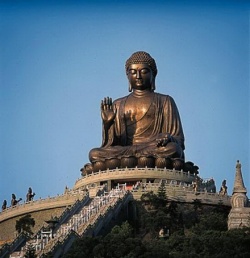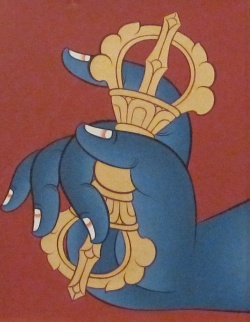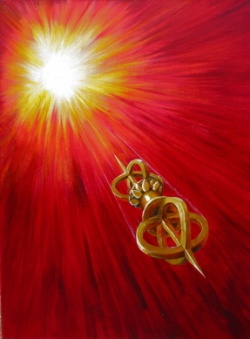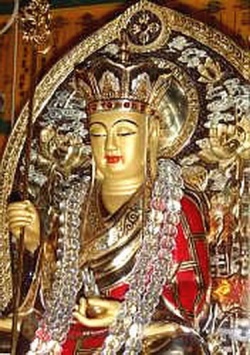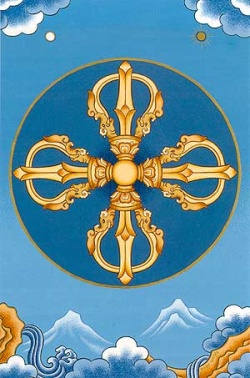First Four Vajra Statements Including the 84,000 Dharma Doors
The are one hundred fifty vajra statements in the Gong Chig. They are called vajra (diamond) statements because they are hard to penetrate. They arise from direct experience and not book knowledge. Just as a diamond cannot be penetrated by other substances, these statement cannot be penetrated by conceptual knowledge. They are also called vajra statements because they are precious and rare. They teach the single viewpoint of the three baskets of teaching and the four classes of tantras.
There are four ways to understand the meaning of these statements. The first is through the words of the Buddha. The second is through the pith instructions of a lama. The third is through yogic direct perception. The fourth is through understanding the history of the lineage. I am basing my explanation on the commentary of Sherab Dorje.
All treatises begins with verses of homage and the resolve to complete the composition of the treatise. The verses of homage are to stainless light, which refers to the mind of Jigten Sumgon, unaffected by afflictive emotions. It refers to him as knowing the three times, just as Shakyamuni Buddha did. Next comes the resolve to compose the text. Then there is a statement of humility by the compiler. He continues with verses praising Jigten Sumgon.
The text has seven chapters. The first is a synopsis of the wheel of doctrine and has 30 statements. We will begin with the first statement. Within Indian commentaries there is a short summary followed by a more extensive explanation. Likewise the first vajra statement summarizes the whole text. It says all the 84,000 dharmas of the Buddha’s teaching reveal the nature and mode of abiding of all phenomena. This means Buddha’s teaching reveals the nature of all phenomena, emptiness, as well as how phenomena appear, cause and effect.
Some commentaries state that Buddha is the king of dharma and can make long short and the unvirtuous virtuous. But that is not how it is, the Buddha reveals things how things are. Some scholars have said that the Buddha can make the past present and sorrow joyful, but that is not how it is. Buddha’s teaching simply states the nature of things out of his compassion for beings. What is unvirtuous results in suffering and virtue leads to happiness. This cannot be changed and affects both sentient beings and Buddhas. From certain causes rise certain results.
All is dependent arising, whose nature is emptiness. We may find it strange to think things are empty when all phenomena appear clearly. But emptiness means all phenomena arise in dependence. Whoever sees the interdependent nature of things sees the mind of the Buddha. Emptiness is a profound teaching and easy to misunderstand. It is not emptiness in the sense that a cup is empty. Instead it means that when we look at a table we see that the name table is dependent on the parts that compose it. And it is dependent on the causes that gave rise to it.
In the same way all phenomena are imputed in dependence on other phenomena. Both the outer world of phenomena and the inner world of mind arise in dependence. Snow flakes arise from the elements of the weather and the water molecules they are made up of. This is why the nature of things is said to be empty. Mind has no form or characteristics. It neither exists or non-exists. It is empty. Yet we experience phenomena even though they are empty. Within emptiness cause and effect appears and cause and effect are also empty. This is the pith of the Buddha’s teaching.
But it is mistaken to neglect right and wrong, saying they are empty. No one creates the relation between the virtuous cause and the good result. That’s just how things are. They are dependent arisings within emptiness. Nagarjuna says there is nothing that is not dependently arisen. Thus there is nothing that is not empty. You cannot understand this just conceptually. You must give up distractions and meditate like Milarepa in order to understand it. Though we may find it hard go off and meditate like Milarepa to understand emptiness, we can understand cause and effect in our daily life.
We can take the lay vows and train in having a good heart and develop the positive qualities that result from practice. And at the time of death we can apply the practices to be reborn in higher realms. But if you want to understand the profound meaning of emptiness you must abandon worldly pursuits, just like Milarepa. So this first vajra statement summarizes the meaning of the entire text. One of Jigten Sumgon’s students said of this first verse that receiving it alone made it worthwhile to be his student.
The second statement says that all 84,000 dharma doors are the method for becoming a Buddha. The number 84,000 is just a metaphor. There are innumerable teachings. But it is said that there are 84,000 afflictive emotions so its said there are 84,000 teachings. Some scholars have said that it is sufficient to practice just one of these teachings to become liberated, just as you can walk through any of the doors of a mansion to get inside. But Jigten Sumgon disagrees. If you miss even one of the 84,000 teachings you have not remedied one of the afflictive emotions and you cannot become a Buddha.
In the Guide to Bodhisattva’s Way of Life it’s said that there is nothing a bodhisattva does not train in. Not a single word of the buddha’s teaching should be left out. Just as every drop of molasses will be sweet, so are all of the Buddha’s teaching. If someone practices Vinaya but not Mantra, they will be lacking the corresponding qualities of Mantra. And the reverse is also true. So all should be practiced. We might feel discouraged thinking how can we practice this. But if we can practice the three trainings of disciple, meditation, and wisdom and the six perfections, these contain all the 84,000 teachings.
The third vajra statement says that the three baskets and the four classes of tantra are the sequence for becoming a Buddha. All the dharma is within sutra, the vehicle of characteristics and secret mantra, the resultant vehicle. The three basket are the Vinaya, Sutra, and Abhidharma. The Sutras teach bodhicitta. The Vinaya teaches the training in moral discipline. And the Abhidharma teaches emptiness. The new translation schools divide the tantras into four classes.
Some scholars think that it is enough to focus on the Vinaya and not practice the other baskets. And the Gelugpa emphasis the practice of conduct. Others say that meditation is the most important and still others that understanding the Abhidharma is all that is needed. Others say you do not need to study tantra, only sutra. And others say you should just study the tantra and not the sutra. But Jigten Sumgon does not agree with this. He says that to become a buddha you need all the three baskets and the four classes of tantra.
When someone is disillusioned with samsara they begin to practice the dharma. They see that all conditioned phenomena are impermanent and all the three worlds are suffering and resolve to become liberated. Based on that they uphold the Vinaya.. They take one of the seven classes of vows, at best those of a fully ordained monk or nun. Those with less fortitude take the novice vows or lay vows. And some will take the eight one day precepts. Based on the foundation of discipline one embarks on the bodhisattva path through the sutras and masters the view of emptiness through the Abhidharma. Just as only a clean white cloth can be dyed, so also one can only embark of the bodhisattva path on the foundation of discipline.
Buddha said in the Sutra of the Three Trainings, based on pure discipline meditative stabilization will arise. And based on meditative stabilization wisdom will arise. And based on wisdom one will be free of the afflictive emotions. And having these three trainings one can enter the door of secret mantra.
The four classes of tantra form a sequence. Action tantra emphasizes actions of the body. Performance tantras emphasize speech. Yoga tantra emphasizes actions of mind. After body, speech, and mind are pure, one enters into Highest Yoga Tantra. What is taught in Highest Yoga Tantra is coemergent wisdom free from constructs, or mahamudra. Based on Highest Yoga Tantra. vajra body, speech, and mind arise, the unity of wisdom and compassion. This is the attainment of the state of Vajradhara.
So the different practices are like a ladder that leads to complete Buddhahood. If one wishes to become a Buddha none of these steps can be omitted. If we think about this, you will see you need both sutra and tantra. Jigten Sumgon outwardly your practice should be that of a shravaka, inwardly you should practice mantra. And both should be embraced by bodhicitta. This is how he harmonizes the three classes of vows.
The fourth vajra statement is the three wheels of dharma are distinguished by the realization of their respective audiences. At the beginning the Buddha developed bodhicitta, in the middle he practiced the two accumulations and at the end he attained enlightenment. After he was enlightened he turned the wheel of dharma three times.
Some scholars say that he taught the first turning to those fearful of suffering. To those attracted to emptiness, he taught the second turning of signlessness. And for those who could not understand emptiness, he taught the third turning of variegated teachings. Others say he taught the three turnings for three distinctive types of disciples. But Jigten Sumgon explains the three turnings in terms of the stages of understanding of a single disciple.
The first turning was taught as the four noble truths to his first five disciples about what it is to be adopted and what is to be avoided. Based on this discipline they became arhats. By sustaining this continuously arhats such as Katyayana developed meditative stabilization. This first turning ripened the minds of disciples. Later he turned the wheel of signlessness, saying everything from form up to omniscience is empty. Based on this they developed special insight. They then recognized that what distinguished themselves from Buddha was bodhicitta. And seeing that the qualities of omniscience could not be obtained without it, they were ready for the third turning of the wheel of ultimate meaning. And through that they became completely and thoroughly ripened.
So unlike other scholars, who say the three turnings are for distinct persons, Jigten Sumgon showed that they applied to each and every person.
Q: Is Jigten Sumgon saying that the teachings of buddha nature are higher than those of emptiness?
A: There is a hierarchy within the three turnings. One progresses through the three turnings. So when you practice, you practice them all, but there is a sequence of realization.
Q: Do you need to practice the shamatha and vipashyana of sutra before you practice tantra?
A: it’s a more stable path if you practice that way. The sequence of practice begins with refuge and vows and progresses from there.
Q: Is there a correspondence between the three baskets and three turnings?
A: Yes, the first turning corresponds to Vinaya the second to Abhidharma and the third to sutra.
Khenpo Choepel
Tibetan Meditation Center
December 30, 2007
